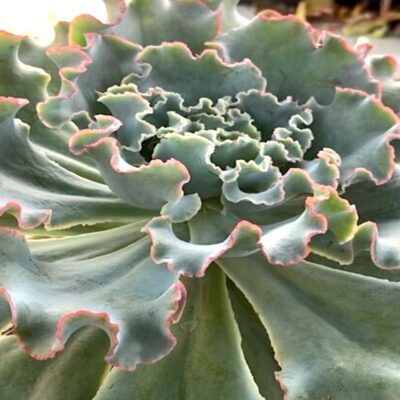
How to Refresh a Succulent Garden
Q: Hi Debra -- My children’s school garden was well taken care of for 12 years, then COVID hit. I’m in charge of getting the succulent area back to its beautiful self. The aeoniums are super leggy, some plants are growing over others, and the fire torches look terrible. We're trying to preserve everything we can. When and what should we cut, replant or add? -- Tiffany in San Marcos
A: Hi Tiffany -- In fall, after summer heat and before winter cold, is a great time to plant, refresh or redo a succulent garden. Winter rain will help cuttings root, and cut stems will produce new growth by spring.
Step-by-Step
- Check irrigation and repair or modify as needed. Note locations of pipes, risers and electrical cords to avoid damage during digging and planting.
- Remove weeds and anything dead or messy. Pull ratty stem succulents (like leggy aeoniums) out of the ground, roots and all.
- Trim healthy top growth and set aside for cuttings. Stems needn’t be long, about an inch is fine. Simply stick upright in soft soil (see how to prepare it in #5).
- Conceal or remove anything utilitarian that jumps out at the viewer. In your photos, these would be the exposed pipe and the blue-green tape that ties the dragonfruit cactus to the bird-feeder pole.

Why does stretchy garden tape come in a color never found in nature? It practically shouts "look at me!"
- The kind of tie I use that doesn’t call attention to itself is Soft-Tie covered wire.
- Watch my video: How to Plant or Redo an Overgrown Succulent Garden
- Amend existing soil, mulch established plants and cover bare spots with mushroom compost or bagged potting soil, to a depth of several inches.
- See how to prune and refresh aeoniums and blue senecio on my website, on my YouTube channel and in this earlier video: Prune and Replant Aeoniums and Senecios. Also on my website see How to Propagate Succulents.
- By “fire torch” you probably mean aloes. No need to do anything. They'll benefit from mulching and will bloom again in winter and spring.
Hope this helps—LMK how it goes! -- Debra
Related Info on this site
When Aeoniums Get Leggy
When aeoniums get leggy, cut off the tops, leaving an inch or two of stem, and throw the rest of the plant away, roots and all. Replant each rosette as a cutting. Insert it into the soil, so it sits just above the ground. The best time
How to Behead and Replant Echeverias
Fancy ruffled echeverias—those large, flowerlike succulents—eventually need to be beheaded and the rosettes replanted. This is a bother, but it comes with a benefit: New clones will form on old, headless stalks. But not always. Here’s how to ensure success.


